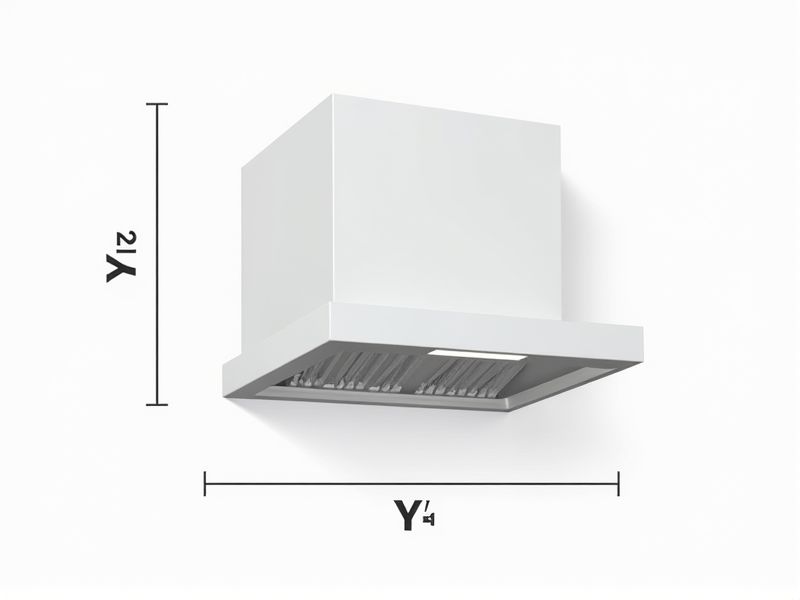
When selecting a vent hood for your kitchen, it's useful to know the standard dimensions to ensure a proper fit and optimal performance. Most residential vent hoods range in width from 30 to 36 inches, matching the standard sizes of cooktops and ranges. The typical height is between 18 and 30 inches, and the depth is usually about 20 to 24 inches to adequately cover the cooking surface. Keeping these measurements in mind will help you choose a vent hood that efficiently captures smoke and odors while complementing your kitchen layout.
Width
A standard vent hood typically focuses on a width range from 30 to 42 inches, accommodating various kitchen layouts. This dimension ensures optimal capture of steam, smoke, and odors generated during cooking. For effective performance, the vent hood should ideally match the width of the cooktop or range beneath it. Your choice of a vent hood with the appropriate width can significantly enhance air quality and ventilation efficiency in your kitchen.
Height
The standard height for vent hoods typically ranges from 24 to 30 inches above the cooking surface to ensure optimal performance and safety. This height range allows efficient capture of smoke, heat, and odors, thus improving air quality in your kitchen. For gas stoves, manufacturers often recommend a clearance of 30 inches, while electric cooktops can function effectively at 24 inches. Proper installation at these heights not only maximizes ventilation efficiency but also contributes to the overall aesthetic of your kitchen space.
Depth
The standard depth of residential vent hoods typically ranges from 20 to 24 inches, ensuring optimal capture of airborne grease, smoke, and odors. For effective performance, the hood should extend beyond the cooking surface by at least 3 inches on each side, providing adequate coverage for various stovetop sizes. When selecting a vent hood, consider its CFM (Cubic Feet per Minute) rating; a general guideline suggests 300 CFM per foot of range width for ideal airflow. Proper depth and CFM ratings enhance ventilation efficiency, improve indoor air quality, and reduce the risk of grease buildup in your kitchen.
Cfm (Cubic Feet Per Minute)
The effectiveness of a vent hood is primarily measured by its CFM (Cubic Feet per Minute) rating, which indicates the volume of air it can move. A higher CFM rating, typically ranging from 300 to 1200 CFM, is essential for efficiently removing smoke, steam, and odors from your kitchen. When selecting a vent hood, consider your kitchen's size and cooking habits, as a powerful unit is crucial for adequately ventilating spaces with high heat production. Ensuring that your vent hood meets or exceeds the recommended CFM for your cooking environment can significantly enhance indoor air quality and safety.
Duct Size
Duct size is a critical factor in the performance of a vent hood, impacting airflow efficiency and noise levels. For optimal performance, a duct diameter of 6 to 10 inches is typically recommended, depending on the range hood's CFM (cubic feet per minute) rating. Proper ducting reduces back pressure, improving the exhaust capabilities and maintaining effective kitchen ventilation. When planning your installation, ensure to adhere to local regulations and manufacturer guidelines for duct size to guarantee safety and efficiency.
Vent Type
Vent hoods primarily fall into three categories: wall-mounted, island, and under-cabinet, each designed for specific kitchen layouts and ventilation needs. Wall-mounted hoods typically require 24 to 36 inches of clearance above the cooktop, while island hoods offer a sleek design suitable for open floor plans. Under-cabinet models are compact and efficient, often measuring 30 to 36 inches in width to fit standard cabinetry. Selecting the right type of vent hood can significantly enhance your kitchen's air quality and eliminate cooking odors, ensuring a pleasant cooking environment.
Installation Type
When selecting a vent hood, the installation type significantly influences performance and aesthetics. Wall-mounted hoods account for approximately 60% of installations due to their effective smoke and odor removal in kitchen spaces. Under-cabinet hoods are also popular, occupying about 30% of the market, as they blend seamlessly into cabinetry while providing necessary ventilation. It's crucial for homeowners to assess their kitchen layout and cooking habits to choose the most suitable vent hood installation type for optimal air quality.
Material
The materials used in vent hoods significantly impact their performance and durability, with stainless steel being the most recommended due to its resistance to corrosion and ease of cleaning. Effective vent hoods often incorporate a minimum thickness of 16 gauge stainless steel to ensure both strength and longevity. Incorporating aluminum or galvanized steel is also common; however, these materials may require more maintenance and are less durable over time. When choosing a vent hood, consider models that utilize high-quality materials to ensure optimal air filtration, noise reduction, and longevity in your kitchen environment.
Noise Level
When selecting a vent hood, pay close attention to the noise level, typically measured in sones or decibels (dB). A standard vent hood operates between 1 to 6 sones, with quieter options being more desirable for a peaceful kitchen environment. Models that generate noise levels below 3 sones are considered particularly efficient and user-friendly. Investing in a quiet vent hood not only enhances your cooking experience but also contributes to a more enjoyable atmosphere in your home.
Mounting Height
The standard mounting height for a range hood is typically between 24 inches and 30 inches above the cooking surface, ensuring optimal smoke and odor capture efficiency. Proper installation at this height not only enhances performance but also complies with safety regulations. A hood mounted too low can obstruct your line of sight while cooking, while one placed too high may reduce its effectiveness. For most kitchen setups, maintaining this standard height is crucial for achieving the best ventilation results.
